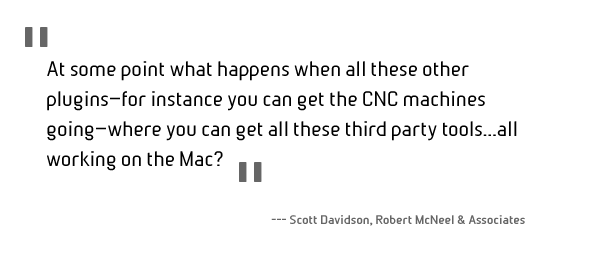Continued from page 1
Grasshopper—Gateway Drug to Programming
Back to the inflection point theory noted earlier…anybody aware of the coding movement pervading academia at the K-12 level, might not be surprised then to see the cultural alignment happening between movements like that and what is happening in the world of AEC.
While only members of advanced computational groups in some of the world’s elite AE firms have been champions of coding and scripting in the past, more and more schools of architecture are rushing this imperative to learn to code.
“We talk sometimes that the elephant in the room—that nobody wants to talk about—is that the design often takes on a life in relationship to the tools,” says Scott Davidson. “Nobody wants that to happen, so the ability to write your own tools, to fit your design, does allow a level of flexibility that you otherwise might not have.”
“I know the AA [Architectural Association] in London,” adds Davidson, “they have been trying to push this agenda—that you gotta know how to program, you gotta know how to script, you gotta know how to do these things…in order to solve your design problems.”

03 – An image capture of a new add-on tool called Conduit by Proving Ground for Grasshopper. The open-source plugin enables designers to create custom data visualizations and heads up displays that update with your parametric model.
Not all people in architectural education are fans of the idea that architects must now know how to code or script…in order to make their own tools, in order that their firm’s designs don’t become shaped by the tools the way automobiles have become shaped by wind tunnel testing. Yet, that is potentially one result of where computation, parametrization, and optimization is going to steer architecture—towards commonness.
“What we have found,” says Davidson, “is if we take 30 people in a class and try to teach them to script by code, probably about five of them will get it…I mean really get it…out of the whole of the class. But, if you teach them with Grasshopper, all but three of the 30 will get it.”
With Grasshopper,” he continues, “people reach a much higher level of understanding of the concepts of scripting or coding.”
So the McNeel folks admit that Grasshopper has become a “gateway drug” of sort…a path to more advanced scripting or complete computer programming. Not only are more advanced programmers trying to do more to talk to Grasshopper…from all kinds of other apps, but those who evaded programming but pass through Grasshopper often end up maturing to the point where they become full computer programmers. This reality is shaping the future of Grasshopper 2.
The Platform Powers That Be—What Led to Mac?
Another factor affecting the future of Grasshopper and Rhino and, quite frankly, the future now of many tools in AEC, is the continued growth in preference for Apple’s Macs.
This is not a new discovery for the McNeel crew; the push for and potential interest in taking Rhino to the Mac platform percolated nearly ten years ago at the Seattle company. This fact was quite shocking to this author, who for years wondered if McNeel’s offices were potentially under the gravitational forces of nearby behemoth Microsoft, the fabled arch nemesis of Apple in the pre-devices era.
However, Davison and Belcher confide that it is the market and their community who they listen to…and these two things change over time. “See, this whole Mac thing is really interesting,” chimes in Davidson. “I don’t think anyone’s ever really cracked that.”
Asking him to explain what he means Davidson responds: “Architects have always really liked the Mac, but it seems that it has always had this kind of ceiling that it can’t break through. Whether it’s fabrication, or documentation…whether it is working with others—who knows what it is—but I think it is going to be interesting to watch [the market] as Grasshopper matures on the Mac side.”
Davidson is referring on some level to the way key tools actually have stymied the Mac’s ability to spread more vigorously across a terrain which has always been receptive. “At some point what happens when all these other plugins—for instance you can get the CNC machines going—where you can get all these third party tools…all working on the Mac?”
Advertisement
Davidson adds: “And the platform is flexible enough where you can start writing things…do we break out of that somewhat limiting thing where—you know—students love the Mac, small offices get work done on the Mac, but larger offices always seem to need the PC?”
These kinds of questions are lingering at McNeel who admit that the commercial version of Rhino for Mac has surprised them. Asked if they feared that the Mac version of Rhino would simply cannibalize Rhino on Windows, Davidson responded—”Oh yeah. Definitely.”
Yet Belcher responds and notes that the Mac is alive and well and it is generating its own customers. While the new Mac Rhino customers come from all sectors, including AEC, a good bulk of them are coming from industrial and product designers. “A lot of them also use Adobe Creative Suite,” adds Belcher, who adds, “it’s funny how many of them ask us to make it work more like Illustrator or something like that.”
Two Voices: Programming the Future
When I asked them if their new Mac customers were more demanding or set the bar higher than Windows user Davidson was responded in the negative. But the voices of the Mac users are in fact a bit different, they admit. “Yes, Mac OS X users have expectations that are driven by their platform,” says Belcher, “but a lot of those expectations actually seem driven by Adobe…even though those tools are largely 2D. In every Adobe application you can click on an element and get its parameters. We hear that every week from our Mac customers; Rhino doesn’t work that way.”
Davidson adds, “We are going to have this unique problem going forward. Basically, we have two groups of very vocal users.” “At some point we are going to have to unify the UI/UX [for both groups] but keep it feeling natural on both platforms. That will be a big but interesting challenge.”
Part 2 Upcoming : More Future Development, Doing Full BIM Rhino, Mac Plugins and Working with Graphisoft





Reader Comments
https://t.co/2QkCpB4Aix Very interesting interview with McNeel devs on the present/future of Rhino/Grasshopper. Features our SG pipeline!
RT @ProvingGroundIO: Disruptions, Platforms, and Growth with #Rhino and #Grasshopper https://t.co/zcV8jGtPuf
RT @AHDeleuran: https://t.co/2QkCpB4Aix Very interesting interview with McNeel devs on the present/future of Rhino/Grasshopper. Features ou…
RT @ProvingGroundIO: Disruptions, Platforms, and Growth with #Rhino and #Grasshopper https://t.co/zcV8jGtPuf
Inflection Point: Disruptions, Platforms and Growth with Rhino + Grasshopper (Part 1) | Architosh https://t.co/cNqbX8jlSI via @sharethis
Inflection Point: Disruptions, Platforms and Growth with Rhino + Grasshopper (Part 1) | Architosh https://t.co/cNqbX8jlSI via @sharethis
[…] pagina seguente: Grasshopper-Gateway Drug Programmazione […]
[…] and computation design communities (like SmartGeometry). He says straight away that architects should learn Rhino, Grasshopper and Grasshopper add-ons—like the Galapagos tool we wrote about earlier […]
Comments are closed.